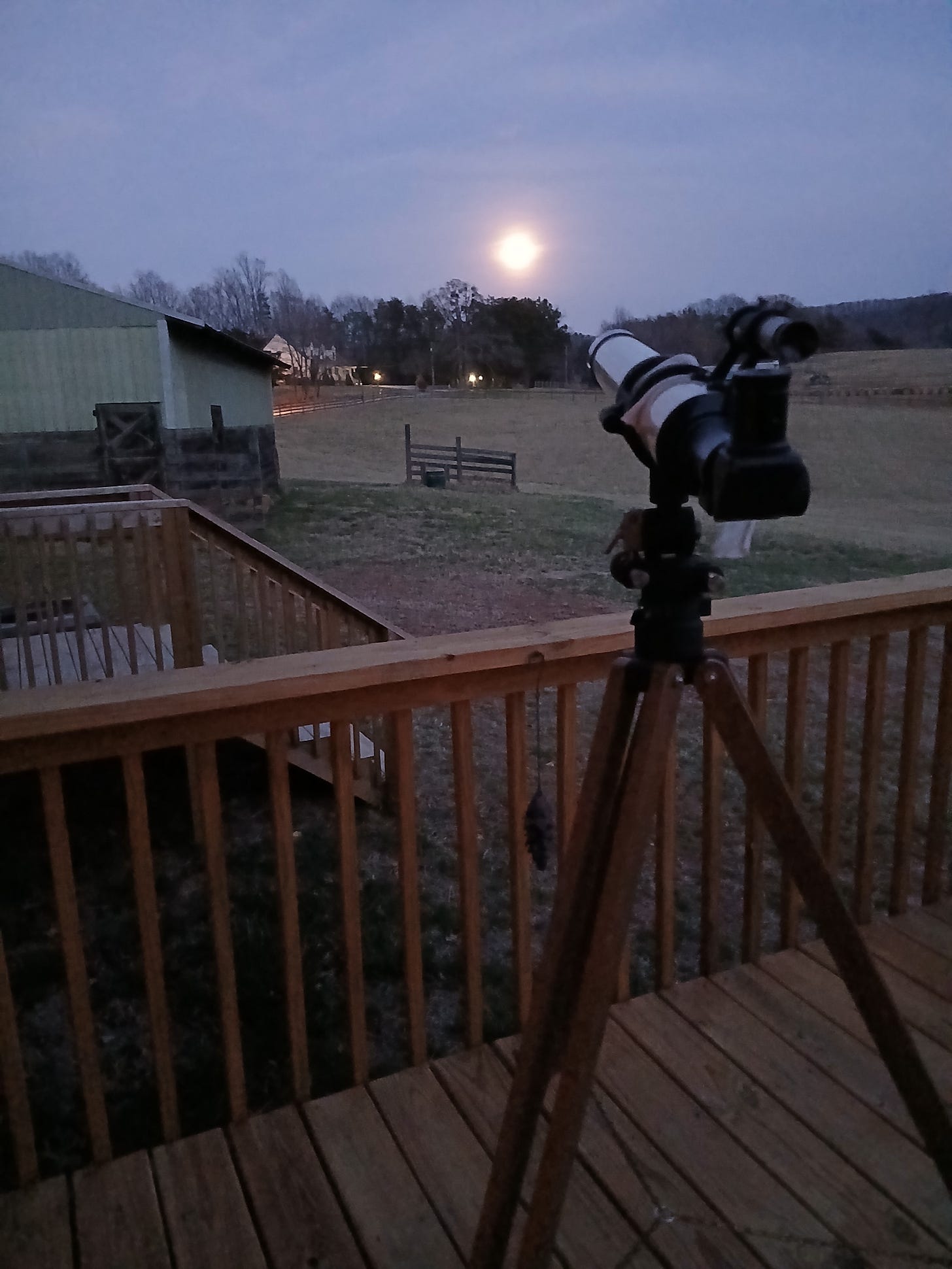It had been quiet most of the day. Around 3 am, the texts started beeping. I’m proud to call these folks friends. “Dig that bluish haze caused by the Ozone layer.”
Then, towards 6, another ding. “Hey, send me pictures if you’ve got any.” I had this photo to the editor at the local paper before I hit the road to Richmond.
Can you believe that’s a cell phone shot? I used an older Samsung Galaxy to snag the view through the TS Optics 102mm ED f/11 refractor, using an Explore Scientific 30mm 82 degree eyepiece. (Now that was a sweet view.)
Oh, there’s nothing like a blood moon, with the geometry of space and the dance of the spheres. And the unpredictable color.
With an early day scheduled, I didn’t stay up for the whole thing (and regret it). The 2:30 am alarm brought me to the back door, and a strange darkness immediately greeted me.
Living away from streetlights makes moonlight obvious, and the wee hours of Friday morning were unusually dark compared to Thursday. I looked up. A copper coin of a moon hung in the sky, eerie, mysterious, beautiful.
I deployed three scopes for the occasion–nerd Christmas, really.
The 102mm ED f/11 TS Optics refractor (a modern Chinese “semi-apo” with 2” focuser and tracking mount) with an Explore Scientific 30mm 82 degree eyepiece (the “Nagler copy”).
The 1964 60mm f/11 Unitron 760 with a stock 25mm Ramsden eyepiece.
The 8” f/7.5 Zambuto-powered “Planet Killer” dob with a 40mm Celestron “Halloween” plossl eyepiece.
Each put up excellent views, and I kept switching between, drinking in the marvelous sight.
The modern refractor had the widest field, presenting a pleasing view of the eclipsed moon and faint starfield. The Dob seemed to have the most faithful color rendition, and tracking is always a joy with it. The Unitron always delights, and makes me realize that any quality telescope is treat to observe with. I get the feeling of riding a bike along a highway. The big shiny cars go whizzing by, but there are breezes to notice on a slower pace.
Speaking of little optics, I grabbed a new pair of 8x42 binoculars, almost as an afterthought.
Wow. The moon looked like a golden balloon, narrowly clearing the pine tree, and then off, up, up, and away, drifting among the stars.
A rooster crowed. It was 4 am. The moon started to climb out of the shadow, and I readied to return to bed. Then, after years of observing, the a-ha moment hit.
I saw the edge of the world.
Here’s what’ll go out in my weekly newsletter for my senior buddies, and on my main blog.
You Are Here
The frogs sang on and off, and finally, a rooster crowed. “Wake up, slackers, it’s 4 AM.” There, by the pine tree, hung the shadow of the world. The moon, coppery-red, begin to climb out of the eclipse. I’d been up since 2:30, mesmerized by the spectacle. Three telescopes trained on it, but it was a simple pair of binoculars that knocked me over. Suddenly, the geometry made sense. That line of shadow–that was here, like seeing the shadow of your own airplane in flight. The deep red staining the dark part of the moon was the refracted sunlight, filtering through our atmosphere. But that boundary between light and dark: that was the edge of the world, cast hundreds of thousands of miles through space, a giant YOU ARE HERE sign. The wars and heroes, cowards, tyrants, and all the characters from Carl Sagan’s “Pale Blue Dot” idea, casting a line on the moon. There I stood, quiet in the 4 am dark, looking past the pine tree, to the moon, then to distant stars, then out into deep space towards faraway galaxies in the Virgo supercluster. I am here.
So I did the only thing that made sense: threw up my hand in a shadow puppet.
(I didn’t see anything.)
Then I went to bed, grateful.
–Josh
View through the “Planet Killer” 8” f/7.5 dob.
The little Unitron 760 tunes up for a long night of moonwatching.







